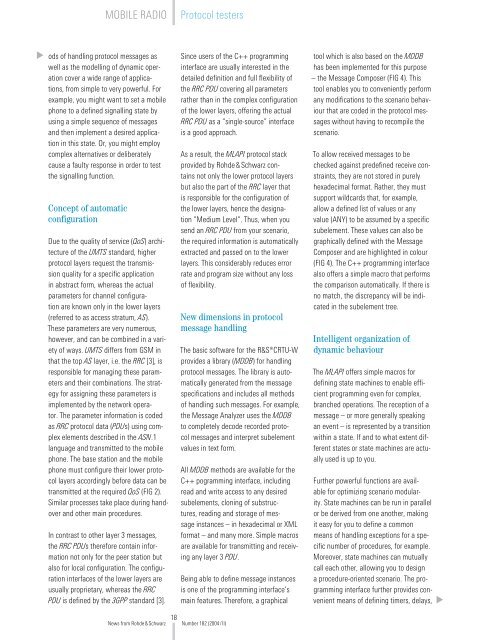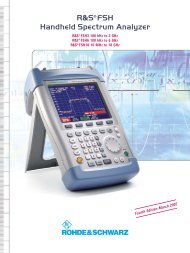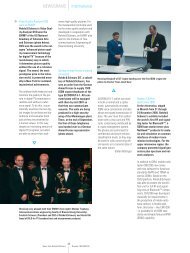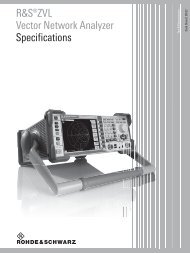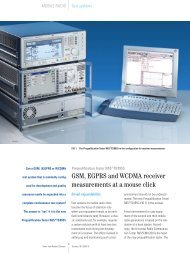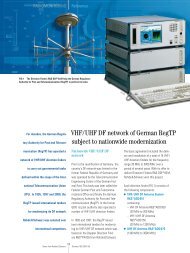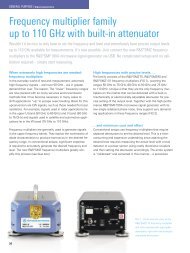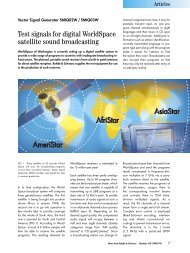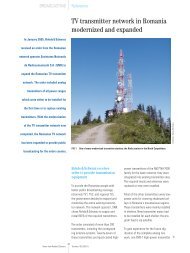Efficient programming interface for UMTS ... - Rohde & Schwarz
Efficient programming interface for UMTS ... - Rohde & Schwarz
Efficient programming interface for UMTS ... - Rohde & Schwarz
You also want an ePaper? Increase the reach of your titles
YUMPU automatically turns print PDFs into web optimized ePapers that Google loves.
MOBILE RADIO<br />
Protocol testers<br />
ods of handling protocol messages as<br />
well as the modelling of dynamic operation<br />
cover a wide range of applications,<br />
from simple to very powerful. For<br />
example, you might want to set a mobile<br />
phone to a defined signalling state by<br />
using a simple sequence of messages<br />
and then implement a desired application<br />
in this state. Or, you might employ<br />
complex alternatives or deliberately<br />
cause a faulty response in order to test<br />
the signalling function.<br />
Concept of automatic<br />
configuration<br />
Due to the quality of service (QoS) architecture<br />
of the <strong>UMTS</strong> standard, higher<br />
protocol layers request the transmission<br />
quality <strong>for</strong> a specific application<br />
in abstract <strong>for</strong>m, whereas the actual<br />
parameters <strong>for</strong> channel configuration<br />
are known only in the lower layers<br />
(referred to as access stratum, AS).<br />
These parameters are very numerous,<br />
however, and can be combined in a variety<br />
of ways. <strong>UMTS</strong> differs from GSM in<br />
that the top AS layer, i.e. the RRC [3], is<br />
responsible <strong>for</strong> managing these parameters<br />
and their combinations. The strategy<br />
<strong>for</strong> assigning these parameters is<br />
implemented by the network operator.<br />
The parameter in<strong>for</strong>mation is coded<br />
as RRC protocol data (PDUs) using complex<br />
elements described in the ASN.1<br />
language and transmitted to the mobile<br />
phone. The base station and the mobile<br />
phone must configure their lower protocol<br />
layers accordingly be<strong>for</strong>e data can be<br />
transmitted at the required QoS (FIG 2).<br />
Similar processes take place during handover<br />
and other main procedures.<br />
In contrast to other layer 3 messages,<br />
the RRC PDUs there<strong>for</strong>e contain in<strong>for</strong>mation<br />
not only <strong>for</strong> the peer station but<br />
also <strong>for</strong> local configuration. The configuration<br />
<strong>interface</strong>s of the lower layers are<br />
usually proprietary, whereas the RRC<br />
PDU is defined by the 3GPP standard [3].<br />
Since users of the C++ <strong>programming</strong><br />
<strong>interface</strong> are usually interested in the<br />
detailed definition and full flexibility of<br />
the RRC PDU covering all parameters<br />
rather than in the complex configuration<br />
of the lower layers, offering the actual<br />
RRC PDU as a “single-source” <strong>interface</strong><br />
is a good approach.<br />
As a result, the MLAPI protocol stack<br />
provided by <strong>Rohde</strong> & <strong>Schwarz</strong> contains<br />
not only the lower protocol layers<br />
but also the part of the RRC layer that<br />
is responsible <strong>for</strong> the configuration of<br />
the lower layers, hence the designation<br />
“Medium Level“. Thus, when you<br />
send an RRC PDU from your scenario,<br />
the required in<strong>for</strong>mation is automatically<br />
extracted and passed on to the lower<br />
layers. This considerably reduces error<br />
rate and program size without any loss<br />
of flexibility.<br />
New dimensions in protocol<br />
message handling<br />
The basic software <strong>for</strong> the R&S ® CRTU-W<br />
provides a library (MDDB) <strong>for</strong> handling<br />
protocol messages. The library is automatically<br />
generated from the message<br />
specifications and includes all methods<br />
of handling such messages. For example,<br />
the Message Analyzer uses the MDDB<br />
to completely decode recorded protocol<br />
messages and interpret subelement<br />
values in text <strong>for</strong>m.<br />
All MDDB methods are available <strong>for</strong> the<br />
C++ pogramming <strong>interface</strong>, including<br />
read and write access to any desired<br />
subelements, cloning of substructures,<br />
reading and storage of message<br />
instances – in hexadecimal or XML<br />
<strong>for</strong>mat – and many more. Simple macros<br />
are available <strong>for</strong> transmitting and receiving<br />
any layer 3 PDU.<br />
Being able to define message instances<br />
is one of the <strong>programming</strong> <strong>interface</strong>‘s<br />
main features. There<strong>for</strong>e, a graphical<br />
tool which is also based on the MDDB<br />
has been implemented <strong>for</strong> this purpose<br />
– the Message Composer (FIG 4). This<br />
tool enables you to conveniently per<strong>for</strong>m<br />
any modifications to the scenario behaviour<br />
that are coded in the protocol messages<br />
without having to recompile the<br />
scenario.<br />
To allow received messages to be<br />
checked against predefined receive constraints,<br />
they are not stored in purely<br />
hexadecimal <strong>for</strong>mat. Rather, they must<br />
support wildcards that, <strong>for</strong> example,<br />
allow a defined list of values or any<br />
value (ANY) to be assumed by a specific<br />
subelement. These values can also be<br />
graphically defined with the Message<br />
Composer and are highlighted in colour<br />
(FIG 4). The C++ <strong>programming</strong> <strong>interface</strong><br />
also offers a simple macro that per<strong>for</strong>ms<br />
the comparison automatically. If there is<br />
no match, the discrepancy will be indicated<br />
in the subelement tree.<br />
Intelligent organization of<br />
dynamic behaviour<br />
The MLAPI offers simple macros <strong>for</strong><br />
defining state machines to enable efficient<br />
<strong>programming</strong> even <strong>for</strong> complex,<br />
branched operations. The reception of a<br />
message – or more generally speaking<br />
an event – is represented by a transition<br />
within a state. If and to what extent different<br />
states or state machines are actually<br />
used is up to you.<br />
Further powerful functions are available<br />
<strong>for</strong> optimizing scenario modularity.<br />
State machines can be run in parallel<br />
or be derived from one another, making<br />
it easy <strong>for</strong> you to define a common<br />
means of handling exceptions <strong>for</strong> a specific<br />
number of procedures, <strong>for</strong> example.<br />
Moreover, state machines can mutually<br />
call each other, allowing you to design<br />
a procedure-oriented scenario. The <strong>programming</strong><br />
<strong>interface</strong> further provides convenient<br />
means of defining timers, delays,<br />
18<br />
News from <strong>Rohde</strong> & <strong>Schwarz</strong> Number 182 (2004/II)


